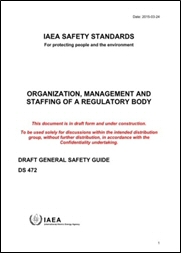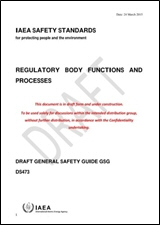IAEA - International
Seismic Safety Centre (ISSC)
ITER contribution to:
- IAEA Safety
Reports Series n° 86 “Safety
Aspects of NPP in Human Induced External Events: General Consideration – issued in 2017. This Report gives the general framework of
methods to be implemented for the design and evaluation of nuclear
facilities subjected to extreme human induced external events.
- IAEA Safety
Reports Series n° 88 “Safety
Aspects of NPP in Human Induced External Events: Margin Assessment – issued in 2017. The objective of this safety Report is to
provide detailed methodology and procedures for assessing the safety
margins of nuclear power plants against human induced events of either the
postulated type or accidental type.
|
|
|
IAEA TSO Forum
ITER contribution to:
- TEC DOC on “Technical and Scientific Support
Organizations (TSOs) providing support to regulatory functions''- January 2018
This TECDOC is intended
to serve as a reference publication on TSOs to better describe the core
characteristics and functions of a TSO supporting regulatory bodies.
This publication
describes the general characteristics, organizational aspects and types of
services provided by TSOs to support regulatory functions and infrastructure in
the Member States. This TECDOC provides a description, including common core
values and characteristics, of TSOs in countries where the regulatory
infrastructure is well established, and it focuses largely on nuclear safety
issues.
- TEC DOC on “Technical
and Scientific Support Organizations (TSOs) and their Services provided in
Support to Regulatory Functions”, Final Draft (February 2017)
The TEC DOC is
intended to report on general characteristics, organizational aspects and types
of services provided by TSOs to support regulatory functions in the Member
States.
This document will
serve as a reference publication on TSOs. It will help to develop convergent
understandings on the matter at international level. It covers
all types of support for safety issues that may be provided to a Regulatory
Body to carry out its statutory functions, which require technical and
scientific expertise in the nuclear and radiation protection field. The support
is applicable to all facilities and activities, for civilian use, that give
rise to radiation risks as defined in IAEA Safety Standard Fundamental Safety
Principles, Safety Fundamentals No. SF-1. Currently this TEC DOC is ready in
its Final Draft.
|
|
|
IAEA TSO Forum
ITER contribution to:
- Safety Guides Working DS472
– “Organization, Management and Staffing of a Regulatory Body”, draft 2015
This Safety Guide covers the
organizational and managerial aspects of Regulatory Bodies, which are of
fundamental importance for the performance of the regulatory core functions in
all circumstances, thus promoting a more consistent approach to organizational
aspects and to resources management. This will allow the Regulatory Body to
have an integrated and overall view of facilities and activities. In
particular, this is to be ensured not only by the technical dimensions, but
also by the cultural, organizational and individual aspects (Human and
Organizational Factors), supporting strong regulatory effectiveness,
supplemented by a questioning attitude and self-reflection on its own culture
and on the influences on the authorized parties.
The scope of this Safety Guide
is limited to the regulation of radiation and nuclear safety and does not
extend to nuclear security. However, it does identify where security measures
are relevant for safety purposes.
|
|
|

|
|
IAEA TSO Forum
ITER contribution to:
- Safety Guides Working
DS473– “Regulatory Body Functions and Processes “, draft 2015
The Safety
Guide covers the core regulatory functions, and how they are discharged, during
all the phases of the lifecycle of a facility or activity from initial design
through to the release from regulatory control by means of associated licensing
processes. However, in line with the graded approach, the regulatory control
and recommendations described will not be applicable to all facilities and
activities and will differ according to the lifecycle stage: even where
applicable, the depth and scope will vary.
The scope of this Safety Guide is limited to the
regulation of radiation and nuclear safety and does not extend to nuclear
security. However, it does identify where security measures are relevant for
safety purposes.
 
|
|
|
IAEA - International
Seismic Safety Centre (ISSC)
ITER contribution to:
- TECDOC on “Safety Communication on Siting of Nuclear
Facilities against External Hazards”, draft 2014
The document provides on how to establish an effective communication,
which contributes to support the shift from one way to two way, interactive and
long-term process of communication with the public as well as it provides
information about the measures taken by nuclear energy stakeholders of a
nuclear national programme to ensure the safety of the public and the
environment, while harnessing the benefits of nuclear power (risk-benefit
evaluation).
Moreover, a risk communication approach identifies the public concerns;
and addresses these concerns, emotions and reactions to work with the media by
answering their demands and provide information in a non- technical language.
It also identifies all stakeholders and affected parties and calls for keeping
them informed about the safety of nuclear facilities, the regulatory control
activities and related findings. Moreover, the risk communication approach
assists in building a bridge between technical experts and the public and
maintain social confidence ensuring transparency and to facilitate the decision
making process by clear, timely, factual and continuous information to the
public.
| | | |